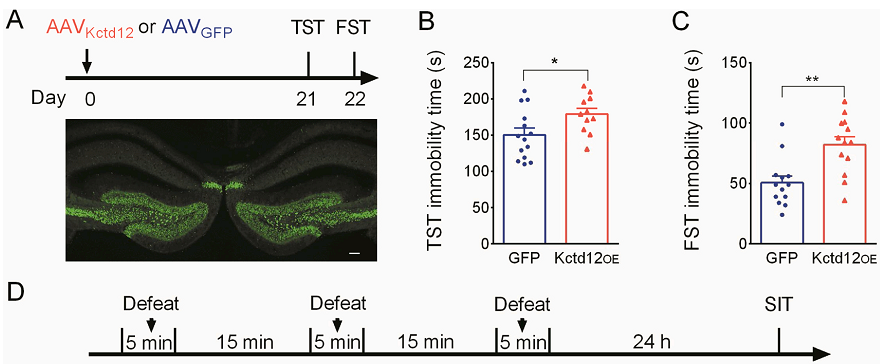Custom-Made AAVs were used for gene over-expression and knockdown. (From
BrainVTA)
The viruses used in this article from BrainVTA are in the table below
|
Custom-Made AAV |
AAV-Ef1α-Kctd12-P2A-EGFP-WPRE-hGHpA
AAV-Kctd12-shRNA-mCherry
AAV-Scramble-mCherry |
|
Control |
PT-0291 AAV-Ef1α-EGFP-WPRE-hGHpA |
Si-Long Deng, Zhuang-Li Hu, Li Mao, Bo Gao, Qiong Yang, Fang Wang, Jian-Guo Chen
Pub Date: 2020-12-04,
DOI: 10.1016/j.phrs.2020.105355,
Email: sales@brainvta.com
Adaptive responses to stress are critical to enhance physical and mental well-being, but excessive or prolonged stress may cause inadaptability and increase the risks of psychiatric disorders, such as depression. GABABR signaling is fundamental to brain function and has been identified in neuropsychiatric disorders. KCTD12 is a critical auxiliary subunit in GABABR signaling, but its role in mental disorders, such as depression is unclear. In the present study, we used a well-validated mice model, chronic social defeat stress (CSDS) to investigate behavioral responses to stress and explore the role of Kctd12 in stress response, as well as the relevant mechanisms. We found that CSDS increased the expression of Kctd12 in the dentate gyrus (DG), a subregion of hippocampus. Overexpression of Kctd12 in DG induced higher responsiveness to acute stress and increased vulnerability to social stress in mice, whereas knock-down of Kctd12 in DG prevented the social avoidance. Furthermore, an increased expression of GABAB receptor 2 (GB2) in the DG of CSDS-treated mice was observed, and CGP35348, an antagonist of GABABR, improved the stress-induced behavior responses along with suppressing the excess expression of Kctd12. In addition, Kctd12 regulated the excitability of granule cell in DG, and the stimulation of neuronal activity by silencing Kctd12 contributed to the antidepressant-like effect of fluoxetine. These findings identify that the Kctd12 in DG works as a critical mediator of stress responses, providing a promising therapeutic target in stress-related psychiatric disorders, including depression.
 Figure 1. Alterations in the expression of Kctd12 protein directly regulate the behavioral responses to stress.
Figure 1. Alterations in the expression of Kctd12 protein directly regulate the behavioral responses to stress.
In the present study, the authors used chronic social defeat stress (CSDS) mouse model to show that Kctd12 in DG works as a critical mediator of stress responses. Thus, the Kctd12 may serve as a promising therapeutic target in stress-related mood disorders like depression treatment.
BrainVTA offers viral vector construction & virus packaging services for AAV, LV, RABV, PRV, HSV and VSV that help researchers explore questions about genes, neurons, circuitry structure, function of brain network, mechanism and treatment of diseases.
If you have any needs, just email us at
sales@brainvta.com.
